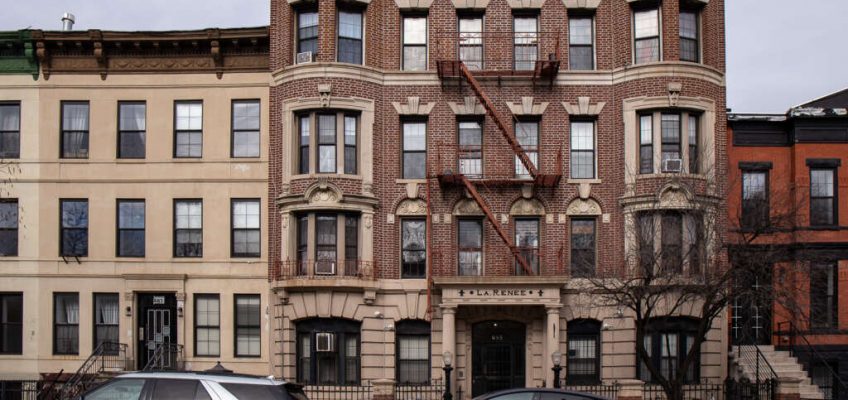The City Council’s just-passed “Rent Transparency Act” will require landlords of buildings with regulated units to display a sign in common areas disclosing that status. “Many tenants living in rent stabilized units don’t know how to determine their legal rent, and in turn, bad landlords have gotten away with illegal rent overcharges and have illegally deregulated units and whole buildings,” said Councilmember Sandy Nurse, who sponsored it.
Apartments in Brooklyn. (Photo by Adi Talwar)
There are roughly 1 million rent stabilized apartments in New York City—units where tenants are entitled to certain protections, including limits on how much their landlord can raise the rent each year—though they aren’t always easy to identify.
But a bill passed by the City Council Thursday will require property owners to post bilingual signs in the common areas of buildings that contain regulated units, disclosing that status as well as letting tenants know they can request the rent history of their own apartment from the state.
“Many tenants living in rent stabilized units don’t know how to determine their legal rent, and in turn, bad landlords have gotten away with illegal rent overcharges and have illegally deregulated units and whole buildings,” said Councilmember Sandy Nurse, who sponsored the bill, said at Thursday’s Council meeting, where the Rent Transparency Act passed unanimously.
In New York City, apartments are typically stabilized if they meet certain rent law criteria—if they’re in buildings built before 1974 with six or more rental units, for example, or if their owners received tax breaks in exchange for keeping rents affordable. Landlords are required to register their regulated units each year, and share a copy of that registration with the tenant. The state’s Division of Housing and Community Renewal (DHCR) maintains a database of those properties.
In testimony during a City Council hearing on the bill late last year, the Real Estate Board of New York, which represents landlords and developers, cited those existing requirements as to why the proposal was “unnecessary,” and said the signs could sow confusion among non-regulated tenants in a building with regulated units, “to mistakenly believe they are entitled to the same rights as rent stabilized tenants.”
“Rent regulated housing owners are already subject to numerous notification requirements, and every rent stabilized tenant receives a lease rider that provides this information,” the group said at the time.
But not all owners comply with the annual registration requirements, making it hard for tenants to know if they’re being overcharged unless they request a rent history for their apartment from the state and do the math themselves.
“It’s happening across the board. There’s 2.5 million rent stabilized tenants,” Nurse told City Limits in a recent interview. She said she’s experienced this confusion herself, having only learned her own apartment was regulated after a housing organizer, who was helping other tenants in the building at the time, suggested she get her rent history from DHCR.
“I just went through my third lease renewal in which the landlord acted as if we hadn’t had the conversation several times, and tried to jack up the rent well beyond what was legally allowed for a rent stabilized unit,” she said. She said she sent the owner a screenshot of her rent history, and they were then forced to offer her the legally-adjusted rent.
“This is me as a councilmember, knowing what I know and having this experience and education level in terms of city government,” Nurse said. “The average New Yorker doesn’t know.”
The law is expected to take effect around the end of the year, Nurse said. The city’s Department of Housing, Preservation and Development will distribute the notification signs to landlords, and they’ll include information in both English and Spanish.
“This building contains one or more units that are subject to the Rent Stabilization Law of 1969. To find out if your unit is registered as rent stabilized, contact the New York State Division of Housing and Community Renewal (DHCR),” the signs are expected to read, according to legislations. “Owners of such buildings must submit an annual filing to DHCR and provide each tenant with a copy of the information that pertains to their unit. Owners that fail to file may be subject to penalties.”
Enforcement will be largely “driven by people who live in the buildings,” Nurse said, as well as HPD staff who will look for the signs when inspecting buildings with regulated units.
The reach the editor, contact Jeanmarie@citylimits.org
Want to republish this story? Find City Limits’ reprint policy here.
The post Does That Building Have Stabilized Apartments? It’ll Soon Be Easier to Know appeared first on City Limits.


Leave a Reply